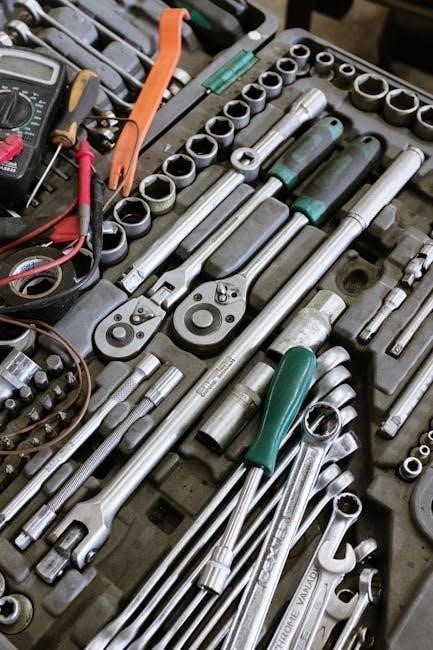The Kreg Jig Screw Size Guide is essential for ensuring proper screw selection, maximizing project strength and durability․ It provides detailed charts and recommendations for screw length, type, and jig setup to suit various materials and applications, helping you achieve professional results every time․
Why Screw Size Matters for Your Kreg Jig Projects
Choosing the correct screw size is crucial for the success of your Kreg Jig projects․ Properly sized screws ensure strong, durable joints and prevent common issues like splitting the wood or creating weak connections․ Using screws that are too short may result in inadequate hold, while screws that are too long can protrude or damage the material․ This is especially important in furniture-making, shelving, and other projects where structural integrity is key․ The right screw size also depends on the type of wood and its thickness, as softwoods and hardwoods have different requirements․ By selecting the appropriate screw length and type, you ensure your project is both functional and visually appealing․ This guide helps you make informed decisions for professional-grade results․
A Basic Guide to Kreg Jig Screw Selection
Selecting the right screws for your Kreg Jig projects involves considering material thickness, screw length, and thread type․ Start by measuring the thickness of your materials to determine the appropriate screw length․ Coarse-thread screws are ideal for softwoods, while fine-thread screws work best with hardwoods․ Pan-Head screws are suitable for most applications, but Maxi-Loc screws provide extra holding power for heavier projects․ Use the Kreg Screw Chart to match your material thickness with the correct screw length and type․ This ensures proper joint strength and prevents issues like wood splitting․ By following this guide, you can simplify the selection process and achieve professional-grade results for your woodworking projects․

Understanding Screw Types for Kreg Jig

The Kreg Jig uses two main screw types: coarse-thread for softwoods and fine-thread for hardwoods․ Pan-Head screws are standard, while Maxi-Loc screws offer greater holding power for heavy-duty projects․
Coarse-Thread vs․ Fine-Thread Screws: Which to Use
Coarse-thread screws are ideal for softwoods like pine, cedar, and spruce, as their deeper threads provide strong hold in less dense materials․ Fine-thread screws, with their tighter threads, are better suited for hardwoods like oak or maple, offering superior holding power without splitting the wood․ Coarse-thread screws are recommended for outdoor or heavy-duty projects, while fine-thread screws are preferred for indoor furniture and fine woodworking․ Pan-Head screws are standard, but Maxi-Loc screws offer greater holding power for demanding applications․ Always match screw type to material and project requirements using the Kreg Screw Chart for optimal results and durability․ Proper selection ensures joints are strong and long-lasting, avoiding common issues like stripped screws or weak connections․
Head Types: Pan-Head and Maxi-Loc Explained
When selecting screws for your Kreg Jig projects, understanding head types is crucial․ Pan-Head screws are the most common choice, featuring a flat underside that sits flush in the pocket hole, ensuring a clean finish․ They are ideal for standard projects and provide excellent holding power․ Maxi-Loc screws, on the other hand, have a larger head and a unique thread design, offering greater holding strength for demanding applications․ Both types are available in coarse and fine threads, catering to different materials․ Pan-Head screws are suitable for most indoor projects, while Maxi-Loc screws are recommended for outdoor or heavy-duty uses․ Blue-Kote screws, with their three anti-corrosion layers, are perfect for damp environments․ Choosing the right head type ensures optimal performance and durability for your project․

Material Thickness and Screw Length
Material thickness determines the optimal screw length for strong joints․ The Kreg Jig Screw Size Guide provides charts to match screw length to material thickness, ensuring proper joint strength and preventing errors․
Matching Screw Length to Material Thickness

Properly matching screw length to material thickness is crucial for strong, durable joints․ The Kreg Jig Screw Size Guide offers a detailed chart to help you select the right screw length based on the thickness of your material․ For example, 1-1/4″ screws are ideal for 3/4″ thick materials, while 1″ screws work best for 1/2″ thick materials․ The guide also accounts for different materials, such as softwoods and hardwoods, ensuring optimal performance․ By referring to the chart, you can avoid screws that are too short or too long, which can weaken the joint or split the wood․ This ensures your projects are secure and professional-grade․ Using the correct screw length also prevents errors and enhances the overall quality of your work․

Using the Kreg Screw Chart for Accurate Selection
The Kreg Screw Chart is a vital tool for ensuring accurate screw selection․ It provides a clear, organized layout of screw lengths, head types, and thread options, making it easy to choose the right screw for your project․ The chart categorizes screws based on material thickness, allowing you to quickly identify the appropriate length and type for your specific needs․ Whether you’re working with softwoods, hardwoods, or specialized materials, the chart offers tailored recommendations․ It also highlights the differences between coarse-thread and fine-thread screws, helping you select the best option for strength and durability․ By referencing the chart, you can avoid common mistakes, such as using screws that are too short or too long, ensuring precise and reliable results every time․ This ensures your joints are strong and your projects stand the test of time․

Setting Up Your Kreg Jig
Properly setting up your Kreg Jig involves adjusting the drill guide to match your material thickness and screw size, ensuring accurate pocket holes for strong joints․
Adjusting the Drill Guide for Proper Screw Placement
Adjusting the drill guide on your Kreg Jig ensures proper screw placement and alignment․ Use the Kreg Screw Chart to determine the correct screw length based on material thickness․ For softwoods like pine or cedar, choose coarse-thread screws, while fine-thread screws are ideal for hardwoods like oak or maple․ Set the drill guide to match the material thickness, ensuring the screw length extends halfway through the second piece of wood․ Properly aligning the drill guide prevents over-drilling and ensures screws sit flush․ Always refer to the chart for accurate settings to achieve strong, consistent joints in your projects․
Using the Kreg Jig Setting Chart for Consistency

The Kreg Jig Setting Chart is a valuable tool for ensuring consistency in your projects․ It provides clear guidelines for setting the drill guide based on material thickness, screw type, and length․ By referencing the chart, you can accurately position the drill guide, preventing errors and ensuring screws are driven to the correct depth․ This tool is especially useful for achieving uniform pocket holes and strong joints across all your projects․ Always cross-check the chart with your screw selection to maintain precision and reliability, ensuring your work meets professional standards every time․

Common Mistakes to Avoid
Common errors include selecting screws that are too short or too long for the material thickness and ignoring the importance of proper jig setup and adjustment․
Choosing the Wrong Screw Length and Thread Type
Choosing the wrong screw length and thread type is a common mistake that can compromise the strength and durability of your project․ Coarse-thread screws are ideal for softwoods like pine or cedar, while fine-thread screws are better suited for hardwoods․ Using a screw that is too short may not provide adequate holding power, while a screw that is too long can protrude from the other side of the material․ Always refer to the Kreg Screw Chart to ensure the correct screw length and type are selected based on the material thickness and application․ Additionally, using the wrong head type, such as pan-head instead of Maxi-Loc for thicker materials, can lead to poor results․ Proper screw selection is critical for achieving professional-grade joints and ensuring the longevity of your project․

Ignoring Material Thickness When Setting Up the Jig
Ignoring material thickness when setting up the Kreg Jig can lead to improper screw placement and weakened joints․ The drill guide must be adjusted according to the material’s thickness to ensure screws are positioned correctly․ Failing to do this can result in screws that are too shallow or too deep, affecting the project’s structural integrity․ Always measure the material accurately and refer to the Kreg Screw Chart for the correct drill guide setting․ This ensures that the screw length matches the material thickness, preventing errors and ensuring strong, durable connections․ Proper setup is crucial for achieving professional-grade results with the Kreg Jig system․



